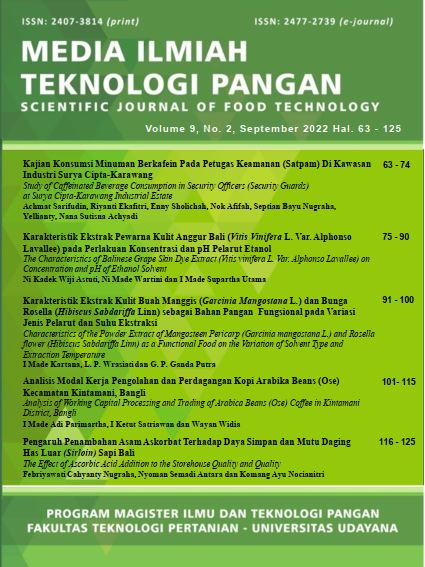PENGARUH PENAMBAHAN ASAM ASKORBAT TERHADAP DAYA SIMPAN DAN MUTU DAGING HAS LUAR (SIRLOIN) SAPI BALI
Abstract
The purpose of this study was to determine the effect of ascorbic acid on the shelf life and quality of Balinese beef sirloin and to determine the concentration of ascorbic acid to produce Balinese beef with the best quality and longest shelf life. The treatments tried in this study were the concentration of 0% ascorbic acid solution; 0.5%; 1%; 1.5% and 2% with 0 storage time; 2; 4; 6; 8 and 10 days at 4 ± 10C. The variables observed were coliform, total plate count (TPC), pH, thiobarbituric acid (TBA), water binding capacity (WHC), color with parameters L*, a* and b*, texture with parameters of hardness, springiness, cohesiveness, gumminess., chewiness and resilience as well as cooking loss (cooking lost). The concentration of ascorbic acid solution and storage time had a very significant effect on (p <0.01) the amount of coliform, total plate count (TPC), pH, TBA, water holding capacity (WHC), cooking lost, sensory which includes preferences of color, texture, taste, aroma and overall acceptance, the interaction of the two also has a real effect. Based on the smallest amount of total plate count contamination, sirloin with a concentration of 2% ascorbic acid solution for 8 days of storage is the best treatment with coliform results of 85.67 ± 1.53 MPN / g, total plate count (TPC) (8.1 ± 12) x 105 CFU / g, pH value 3.56 ± 0.02, thiobarbituric acid (TBA) value 0.39 ± 0.01, water binding capacity 40.98 ± 0.01%, color L* = 25.55; a* = 5,51; b* = 10.61, hardness texture = 1911.10 ± 0.28; springiness = 1.00 ± 0.03; cohesiveness = 0.65 ± 0.03; gumminess = 692.75 ± 0.02; chewiness = 600.86 ± 0.22; resilience = 0.55 ± 0.02 and cooking loss (cooking lost) 40.24 ± 0.20%. The characteristics of Balinese beef sirloin meet the Indonesian National Standard (SNI 3932 - 2008).








